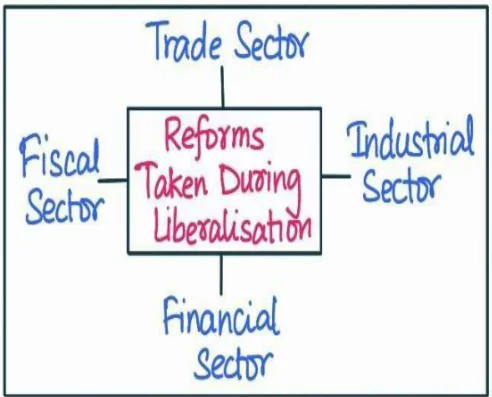Answer:
|
How to approach the question
- Introduction
- Write about India’s economic liberalization briefly.
- Body
- Write the correlation between India’s economic liberalization and its growth trajectory.
- Write the arguments and evidence that suggests the process of liberalization in India remains incomplete.
- Write suitable way ahead in this regard.
- Conclusion
- Give appropriate conclusion in this regard.
|
Introduction
India’s economic liberalization, initiated in 1991, aimed at ending license-raj, reducing government intervention, and promoting globalization. The focus shifted to free-market principles, causing a significant transformation. It sparked a robust GDP growth, improved living standards, and enabled India’s emergence as a global player as third largest economy in PPP terms.
Body
Correlation between India’s economic liberalization and its growth trajectory
- Improved GDP: The liberalization of India’s economy led to a dramatic increase in its Gross Domestic Product (GDP). In 1991, India’s GDP was around $270 billion, and by 2020, it had skyrocketed to approximately $2.6 trillion.
- Foreign Direct Investment (FDI): It opened the gates for FDI. Pre-1991, FDI was almost non- existent. However, post-liberalization, many foreign companies like Coca-Cola, Pepsi, McDonald’s, and others entered the Indian market, contributing significantly to its economy. Example- In 2022, India received FDI worth $49.3 billion.
- Service Sector Boom: Post-liberalization, the service sector emerged as a significant part of the Indian economy. IT giants like Infosys, TCS, and Wipro gained global recognition, generating considerable foreign exchange.
- Reduction in Poverty: Liberalization helped reduce poverty rates in India, with the percentage of the population living under the poverty line decreasing from 45.3% in 1991 to around 21.2% by 2011.
- Stock Market Growth: It saw a significant surge after the LPG reforms. Increased participation of foreign and domestic institutional investors led to higher market capitalization, exemplified by the Sensex’s rise from around 1,000 points in 1991 to over 50,000 points by 2021.
- Foreign Exchange Reserves: India’s foreign exchange reserves jumped from about $5.8 billion in June 1991 to over $590 billion by January 2021. This increase signaled improved confidence in the Indian economy and provided a cushion against financial crises.
Arguments and evidence that suggests the process of liberalization in India remains incomplete
- Land Acquisition Laws: Land acquisition is a complex process in India due to intricate laws, resulting in delayed or stalled infrastructure projects, like the Navi Mumbai airport, which faced years of delay due to land acquisition issues.
 Judicial Delays: The judicial process in India is known for its lengthy delays. For instance, cases like the Vodafone tax dispute have taken years to resolve, creating uncertainty and discouraging foreign investors. Example- In subordinate court, the average case life is nearly 6 years.
Judicial Delays: The judicial process in India is known for its lengthy delays. For instance, cases like the Vodafone tax dispute have taken years to resolve, creating uncertainty and discouraging foreign investors. Example- In subordinate court, the average case life is nearly 6 years.- Government Disinvestment: The government’s stake in PSUs remains high. Despite plans to disinvest in entities like Bharat Petroleum Corporation Limited (BPCL), the process has been delayed, signaling reluctance to reduce government control. Example- In last 1 decade, government has met its disinvestment target only twice.
- Agricultural Sector: Despite liberalization, the agricultural sector, employing about half of India’s workforce, remains heavily regulated. Examples include the Essential Commodities Act and state APMC laws, which limit the freedom of farmers to sell their produce.
- Restrictions on FDI: Some sectors of the Indian economy, like multi-brand retail and insurance, still have significant restrictions on Foreign Direct Investment (FDI). These limits slow the inflow of foreign capital and technology, stifling growth potential.
- Tax Regime: Despite the introduction of GST, India’s tax system remains complex, with high levels of both direct and indirect taxes. This complexity can discourage entrepreneurship and investment.
Suitable way ahead in this regard
- Labour Law Overhaul: India needs to modernize its labor laws to balance worker protection and ease of doing business. Recent labor codes are a good start, but they need to be implemented effectively to make a difference.
- Simplify Tax System: India should work on simplifying its tax regime. For instance, having a dual (lower and standard) GST rate could be a way forward, reducing the compliance burden on businesses.
- Speedy Judicial Process: India needs judicial reforms to ensure timely resolution of commercial disputes. Fast track courts for commercial disputes, as seen in Singapore, can be an effective model.
- Land Acquisition Reforms: Land acquisition processes need to be streamlined to aid infrastructure development. A clear, fair, and faster process would reduce project delays, like those faced by infrastructure project.
- Privatization and Disinvestment: Accelerating the pace of privatization and disinvestment in PSUs can bring efficiency and free up resources for essential public spending. Air India’s successful disinvestment could be a model for other PSUs.
- Strengthening Regulatory Institutions: Regulatory bodies need to be strengthened to reduce policy uncertainty. For instance, the role and functioning of bodies like TRAI should be reviewed to ensure predictable policy environments for businesses.
Conclusion
India’s journey of economic liberalization has catalyzed substantial growth and global recognition. These suggested ways forward should be implemented effectively to address persisting challenges to spur growth, improve the business environment, and ensure that the benefits of economic growth are widely shared.
To get PDF version, Please click on "Print PDF" button.
 Judicial Delays: The judicial process in India is known for its lengthy delays. For instance, cases like the Vodafone tax dispute have taken years to resolve, creating uncertainty and discouraging foreign investors. Example- In subordinate court, the average case life is nearly 6 years.
Judicial Delays: The judicial process in India is known for its lengthy delays. For instance, cases like the Vodafone tax dispute have taken years to resolve, creating uncertainty and discouraging foreign investors. Example- In subordinate court, the average case life is nearly 6 years.
Latest Comments